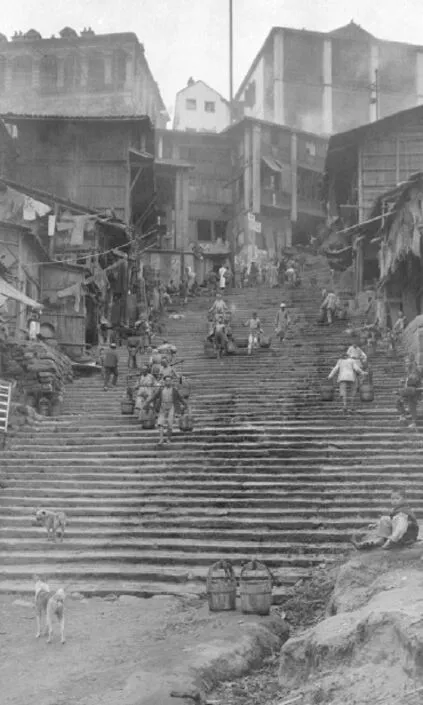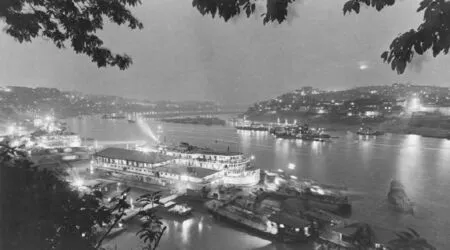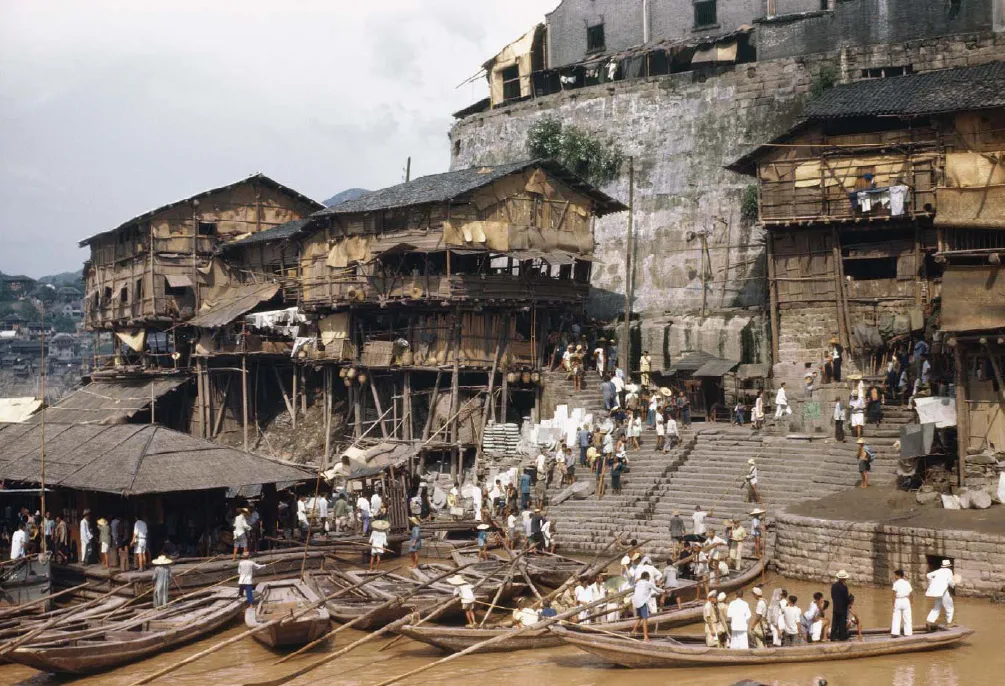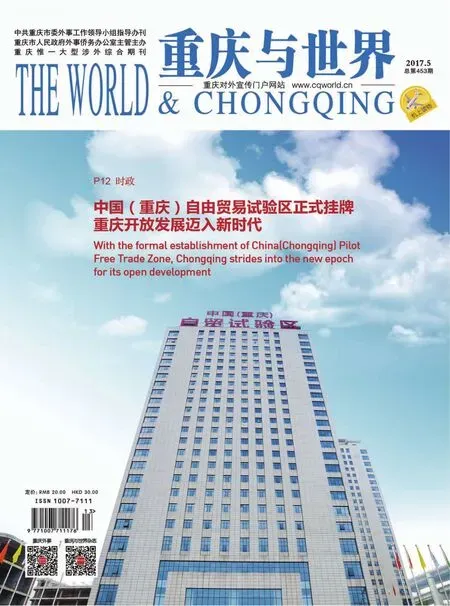一场关于朝天门的集体回忆
□文/本刊记者 杨艳
一场关于朝天门的集体回忆
□文/本刊记者 杨艳

上世纪60年代的朝天门。摄影:程良健(图片由重庆市客轮公司提供)
集大之展 来自境内外上千张老照片
“1948年我父亲来到重庆,为了糊口,经熟人介绍在搬运工头处登记名字,取证件,就在朝天门码头搬运货物,那时的朝天门停靠了许多木船,很热闹。”这是重庆公路运输(集团)有限公司退休员工冯阿姨从父亲口中听到的关于朝天门的回忆。朝天门屹立在山城,作为重庆发展变迁的标志与符号,在每个重庆人心中留有特殊的印记。
3月中旬,在重庆直辖20周年之际,上千幅拍摄重庆朝天门、长江三峡等地的珍贵历史图片亮相重庆国泰美术馆,这场由重庆市渝中区人民政府主办的大型历史影像展《永远朝天门》,首次集中展现了重庆开埠、发展、抗战、直辖等时期的影像,展出的照片所拍摄时间从1870年到现在,跨越147年之久,记录着重庆城的巨变,还记录着一代又一代重庆人的成长。
展览期间,无论是像冯阿姨这样生在重庆长在重庆的市民,还是近年才移居重庆的外地人,又或是路过这座城市的旅行者,但凡参观过展览的人,无一不被这大量的文献影像所震撼。珍贵老照片更唤起了人们对朝天门及渝中区母城的集体回忆,他们纷纷心怀敬意地来到现场,在千张影像中寻觅儿时的住所和曾经玩耍的地方。
在接受《重庆与世界》记者采访时,执行策展人王远凌说,这不止是一场关于朝天门的文献影展,更是整个重庆发展与变迁的摄影实录。“朝天门,作为重庆码头中最重要的部分,经历了太多改变,我们不能否认它的坚实与勇敢,在地图它虽然只是一个地标,但实际上是重庆人的精神内核,重庆人骨子里的坚韧与它有着惊人的相似。”据他介绍,从文史图片的收集、整理筛选,到现场规划,此次展览筹备一年之久,得到广大群众以及境内外机构的支持,照片来自摄影师、市民、博物馆、老牌国企等,大多无偿将老照片提供给展览方,并无偿地参与资料录制。
在展览作品中,我们看到有国际级大师英国摄影家纳达夫·坎德尔、美国战地记者卡尔·麦当斯的作品,有第一批进入重庆的外国人英国摄影师约翰·汤姆逊、英国传教士罗贝特·陶维新早在19世纪末的照片,还有一些由马格南图片社、帕诺斯图片社、瑞士摄影基金会、英国布里斯托大学中国历史照片研究中心、法国尼埃普斯摄影博物馆等提供的影像资料。其中,近代朝天门的影像资料多数来自境外,这也是19世纪后期重庆开埠以来,向中国和世界的第一次集中展示,弥足珍贵。
他者之眼 识老照片忆“门户”往事
“从古至今,从一个时代的繁忙到一个时代的繁荣,再到另一个时代的繁华,朝天门发生着巨大的变化。”这是参观者内心发出的共同心声。朝天门码头自古是外来人及物资进入重庆的大门,是当之无愧的“重庆第一门户”,这有理可据。

长长的石梯是山城的特色。(图片由中国历史图片研究中心提供)
明初时期,朝臣戴鼎奉旨扩建重庆旧城,依照九宫八卦之图建造共计17座城门,而其中规模最大的一座城门被命名为朝天门,以此表明臣子对朝廷的敬重。“那时圣旨传来,经长江到达朝天门,全城迎官接圣,朝天门最早就被赋予了如此之高的政治功能。”前重庆市文联党组书记蓝锡麟说。
重庆城有3000年历史,朝天门就如一个起点,一个发祥地。“重庆人的居住、繁衍是从朝天门开始,所有建筑从朝天门逐步向七星岗通远门方向延伸,形成一座古城,古城大概有2.3平方公里,正是17个城门围合的面积,整个城墙长8000多米。”重庆城市规划建设专家何智亚介绍了古城的大致情况。
重庆市文化遗产研究院研究员、古城研究专家袁东山研究山城防御体系20多年,他主要研究重庆城的空间演变,从古城的空间设置上,他进一步道出了朝天门城门的重要性:“渝中区的地形就像一片树叶,从朝天门到佛图关,地形逐渐增高,以此突出朝天门区域的独特性,朝天门有头道门、二道门、三道门,形成三个瓮城,其中有一栋澄清楼,是宋蒙战争时期抗蒙名将余玠的招贤馆,在2010年的时候我们还找到了衙署大门,这些重要府邸、衙署以及三道门洞的防御体系的设置,足见朝天门在17扇城门中的重要性。”

上世纪70年代朝天门夜景。(图片由Gettyiamges提供)
直到开埠时期,朝天门成了中国内陆最早的对外通商口岸。英、日、美、法各国纷纷来到重庆设领事馆,开设公司、洋行。海关设立在朝天门,当时的重庆海关管辖范围是:长江上起南岸黄葛渡土地庙和北岸城墙西端,下迄南岸窍角沱铁厂和北岸安溪石桥,全长3英里。嘉陵江从朝天门上溯1英里为止,所有过往的中外船只必须在此水域内停泊,按规定报关并接受抽查。
在此次展览中,一批在百年前以重庆人为视觉中心的照片,吸引了众多参观者,这些照片记录下重庆人清贫生活和勤劳奋斗的细节:重庆人在江边挑水,船夫合力划船……这是1917年,美国社会经济学家西德尼·戴维·甘博考察中国时留下的珍贵影像。因得天独厚的地形与源源不断的水运资源,朝天门在那时就成为大西南水运重镇。大量沿江而来的各种货物在朝天门集散,引来了庞大的人流聚集,有搬运工、纤夫、轿夫、挑水夫……那时的朝天门一片繁忙景象。“老人常说少不出川,其实出川就是从朝天门出去,到夔门,然后走出去看世界,回来也是从朝天门回来,当年重庆第一辆小汽车就是从朝天门一步步抬上来的。”在青年雕塑家刘景活的眼里,朝天门就是重庆人打开世界的窗口。
直到重庆第一任市长潘文华来渝主持重庆码头的新建和改、扩建,依旧以朝天门为原点。那时的重庆“一面当陆,三面滨江”,人口与店铺大多集中在渝中区陕西街至朝天门的旧城区一带,城市空间十分狭小,全城还没有一条马路,滑竿、轿子是当时主要的交通工具。从1927年开始,重庆商埠督办公署决定修建3条市区交通干线,就以朝天门为中心,向两路口、菜园坝、曾家岩发展。蓝锡麟说:“从明清时期一直到民国前期,朝天门就一直是重庆的政治中心、经济中心,最繁华的地段就在下半城,并非是现在的解放碑位置。”
众人之心 建设中那些感动瞬间
20世纪50年代,朝天门码头惠泽百姓民生。据重庆公路运输(集团)有限公司退休员工邓永利回忆,1952年重庆成立第一家搬运公司,那时重庆的码头有朝天门、大溪沟和菜园坝,朝天门码头主要运输粮食、水果、面粉等生活用品,大溪沟码头运输煤炭、河沙、石子等,菜园坝码头主要运输建筑材料。朝天门码头对重庆市民的日常生活,以及国民经济的恢复起了举足轻重的作用。

上世纪40年代的朝天门。(图片由《国家地理》提供)
1998年,重庆直辖后的第二年修建朝天门广场,它的建立在重庆人心中留下了浓墨重彩的一笔。“修建朝天门广场是一个极其光荣的任务,它的建成树立了重庆直辖后的城市形象,老百姓也在这个项目中看到了城市发展的希望。”曾参与过朝天门广场修建的何智亚回忆了当时修建时的情景,“大家的热情高涨,晚上时常有人自愿留下来加班,我当时纳闷,白天已通过审核的工程,晚上为何还要加班呢?现场的工人告诉我,他们认为没有达到最好的效果,于是自愿加班返工。”朝天门已成为人们怀旧,寄托乡愁的重要载体。
“朝天门的发展不是某个人的功劳,是随历史发展自然形成,这绝非偶然。”原重庆市人大常委会副主任王洪华说,朝天门广场的建设与渝中区旧城改造项目血脉相连,与滨江路环线的建设骨架相通。要说朝天门广场的修建,就不能不谈滨江路的修建工程。“渝中区滨江路的建设规划早在抗战时期就已被人提及,但那时没有条件实现,直到改革开放后才有了实现的可能。记得在修建滨江路1公里示范段时,这个项目就是一个‘感动上帝’的工程,由于费用有限,很多人自愿加入修建队伍,解放军、大学生、工人、农民等都赶来义务劳动。当这段路修建成功,大大鼓舞了市民的信心。”回忆当年那段大拆迁、大建设、大发展的艰苦岁月,许多重庆人都认为这些付出是值得的,改革开放带来的城市巨变,是当年数十万渝中人为幸福生活努力奋斗的结果。
朝天门广场建成后设置了“零公里”地理标志,意味着这里就是城市干线公路的起点,是一个城市中心点的象征。它的亮相,也成为不少市民和游客来到朝天门广场必看的一景。
20世纪90年代开始,朝天门进入一个新的繁荣时期。那时的朝天门综合交易市场生意极度兴旺,新潮的服装批发炙手可热。“2000年到2005年期间,是朝天门最火爆的时候,朝天门综合交易市场在全国批发行业拥有极大影响力,每天凌晨4点,大正商场的门口就等满了人,人与货物挤在门口,交通也时常受阻,当商场大门才开了一半,人们便蜂拥而至,火爆程度可见一斑。”当年,朝天门综合交易市场就是重庆商贸交易的一张“名片”,不少商户在这里创业、发家、致富,对于老一代渝商来说,这里是他们发家致富的风水宝地。
不此如此,朝天门码头作为老百姓生活休闲之地,也曾发生了不少趣闻轶事。重庆市地方史研究会会长周勇曾是重庆市体工队的跳水队员,他回忆道:“跳水队的孩子经常到朝天门三码头的桥墩去跳水,有一次我把衣服脱在岸边,游完泳发现衣服不见了,我家住在沧白路,于是我只好光溜溜地从朝天门走到沧白路,这段儿时趣闻时常成为我们一家人的回忆。”
未来之望 新建筑翻开城市新篇章
时代在变,格局在变。2012年8月,随着一声巨响,朝天门重庆港客运大楼和三峡宾馆成功爆破,又一次开启朝天门的新建设征程。一座命名为“朝天扬帆”的新建筑将落地朝天门,据了解,这个新建筑将与朝天门广场连为一体,看上去就像一艘扬帆起航的轮船。
与此同时,朝天门综合交易市场也将打开新格局,业态上将进行新调整,目前一大批仓储、物流、批发等业态正在被淘汰,未来的朝天门市场将构建成以电子商务为依托、线上线下融合发展的现代综合商贸体系,涵盖商贸、办公、旅游、文化等多元化业态。
有许多自小就在渝中区长大的重庆人,跟朝天门建立了深厚的感情,对于朝天门的变迁,怀着一种复杂心情,重庆前文联副主席李自治就是其中一位。1969年他知识青年下乡,就是从朝天门启程,朝天门在他们这一代重庆人心里留下了许多回忆。看到城市建设一天天变化,从前的记忆变得越来越少,他们高兴之余难免有些感伤,但更对朝天门的建设寄予厚望。
这场大型影像展虽已结束,重庆人对朝天门的回忆却从未停止,对于朝天门的期望,还在继续发酵。我们有理由相信,朝天门的改变,也预示着重庆母城将翻开新的篇章。
(本文所有图片经活动方授权使用,版权归原作者所有,未经授权不得转载)
A large-scale exhibition pooled with over one thousand domestic and foreign old photos
In the middle of March, it marked the 20th anniversary of Chongqing being a municipality directly under the central government.More than one thousand precious historical photos showing Chantianmen, the Yangtze Gorges and other Chongqing places were displayed in the Chongqing Guotai Art Museum.Sponsored by People’s Government of Chongqing, Yuzhong District, this large-scale historical image exhibition themed with“Eternal Memory about Chaotianmen” firstly focused on the presentation of images showing Chongqing historic development during the periods of opening-up, further development, anti-Japanese War and being municipality.Those displayed photos span a long time of 147 years from 1870 to the present, and record both tremendous changes of Chongqing and the growth of generations of Chongqing people.
In an interview with magazineThe World & Chongqing, Wang Yuanling, executive of this exhibition, said that it’s not just a documentary photo display about Chaotianmen, but the photographic records of Chongqing’s development and changes.He introduced that this exhibition has won great supports from the broad masses and domestic and foreign institutions.The displayed photos are offered by photographers, citizens, museums and old state-owned enterprises who offer these old photos to the exhibition party and participate in the material recording for free.
In this exhibition, we can see works created by Nadav•Kandel, an international British photographer and Karl•Mados, the American war correspondent, photos about the first group of foreigners who entered Chongqing as early as the end of nineteenth century like British photographer John Thompson, British missionary Robert Tavinovo, and image materials offered by Magnum Photos, Panos Photos, Swiss Photography Foundation, research center for Chinese historical photos in the University of Bristol and Nièpce Museum of Photography in France.
Appreciate old photos to recall the memory about Chaotianmen from a different view
In early Ming Dynasty, the courtier Dai Dingfeng was on Emperor’s order to work on the expansion of the old city of Chongqing.A total of 17 city gates were built in accordance with the Diagrams of Jiugong and Bagua (the terms from Chinese ancient astronomy), among which Chaotianmen represented the biggest one, showing vassals’ great respect for imperial court.Lan Xilin, Former Secretary of the CPC Chongqing Literary Federation said, “at that time, imperial edict arrived in Chaotianmen through the Yangtze river.Chaotianmen served as a place welcoming senior officials and receiving imperial edict with a key political function.
Yuan Dongshan, researcher of Chongqing Academy of Cultural Heritage and expert of ancient city, has studied defense system of mountain city for 20 years and mainly worked on the study of Chongqing spatial evolution.He voiced the importance of Chaotianmen again from the spatial arrangement of ancient city that terrain in Yuzhong District shaped like a leaf is to rise gradually from Chaotianmen to Fotuguan, contributing to its geographic uniqueness; in fact, there are three gates lined in order, which brings about such spatial arrangement that Wengcheng (small town outside the city gate), mansion house and government office stand in line; it’s self-evident that Chaotianmen has a superior ranking among these 17 gates since it is equipped with a defense system of three gates.
When Chongqing was designated as commercial port, Chaotianmen became the earliest foreign treaty port built in Chinese inland.Since British, Japan, America and France came to Chongqing to set up consulate, start companies and foreign banks, the Customs was built in Chaotianmen.A series of precious images were displayed in exhibition, all of which were shot in 1917 when Sidney•David •Gambo, the American social economist, conducted an investigation of China.In viewing these photos, we can see that Chaotianmen became an important shipping town at that time since it was endowed with unique advantageous terrain and a steady shipping resource.The young sculptor Liu Jinghuo said, “elderly people often say young people would not like to go out of Sichuan; people who want to leave Sichuan must fi rstly start their journey in Chaotianmen, travel to Kuimen, and then go out to see the outside world; they have to follow the route when coming back to Sichuan; besides, it’s from the Chaotianmen that the first car was lifted up.” He also praised Chaotianmen as the window for Chongqing people to have access to the outside world.
When Pan Wenhua, the first mayor of Chonqging, presided over the construction and renovation of Chongqing ports, Chaotianmen was still taken as the base.
Working in union witnesses those touched moments during the construction
In 1998 when Chongqing became a municipal city, construction of Chaotianmen Square weighed heavily in the mind of Chongqing people.He Zhiya who ever participated in its construction recalled the scene at that time and said, “it’s a glorious mission to build Chaotianmen Square; its construction has set up a sound city image for the later Chongqing’s municipality while residents also catched a glimpse of hope of city’s development.” He added, “at that time people were so enthusiast that some people were willing to work overtime in the evening.” Therefore, we can see that Chaotianmen becomes an important carrier for Chongqing people to recollect reminiscence and express nostalgic sentiment.
Wang Honghua, former deputy director of the Standing Committee of Chongqing People’s Congress, said, “when it comes to the construction of Chaotianmen Square, we have to talk about the construction of Binjiang Road; I remember that in building one-kilometer demonstration section of Binjiang Road, this construction was doomed to be a God’s tearsshedding project since despite of limited funding, lots of people volunteered to participate in this project; citizens’ confidence was significantly raised by the completion of demonstration section.”
At the beginning of 1990s, Chaotianmen entered into another prosperous period.As integrated trading market in Chaotianmen was flourishing at that time, it acted as a famous brand representing Chongqing trade and business.
The future star - new building opens a new chapter for Chongqing
As the era is changing, pattern of development is also moving forward.In the coming days, a new building named “Chao Tian Yang Fan” (referred to a great expectation for further development of Chaotianmen as its Chinese name means a sailing boat) will be built in Chaotianmen.It is said that this new building will be linked together with Chaotianmen Square, which looks like a sailing boat.
At the same time, Chaotianmen’s integrated trade market will open up a new pattern with some adjustments in businesses.At present, a large number of businesses like warehousing, logistics and wholesale are being phased out.It is said that Chaotianmen market in future will build a modern integrated trade system which is to rely on e-commerce, combine online and offline development and cover multiple businesses including trade and business, office work, tourism and culture.
Even though this large-scale exhibition came to the end, Chongqing people’s memory to Chaotianmen never faded, and their expectation of Chaotianmen continues to grow up.We have every reason to believe that changes occurred in Chaotianmen indicate that a new chapter will be opened up in main regions of Chongqing.
(Pictures are provided by the sponsor)
A Collective Memory about Chaotianmen
□ Article / Journalist Yang Yan

